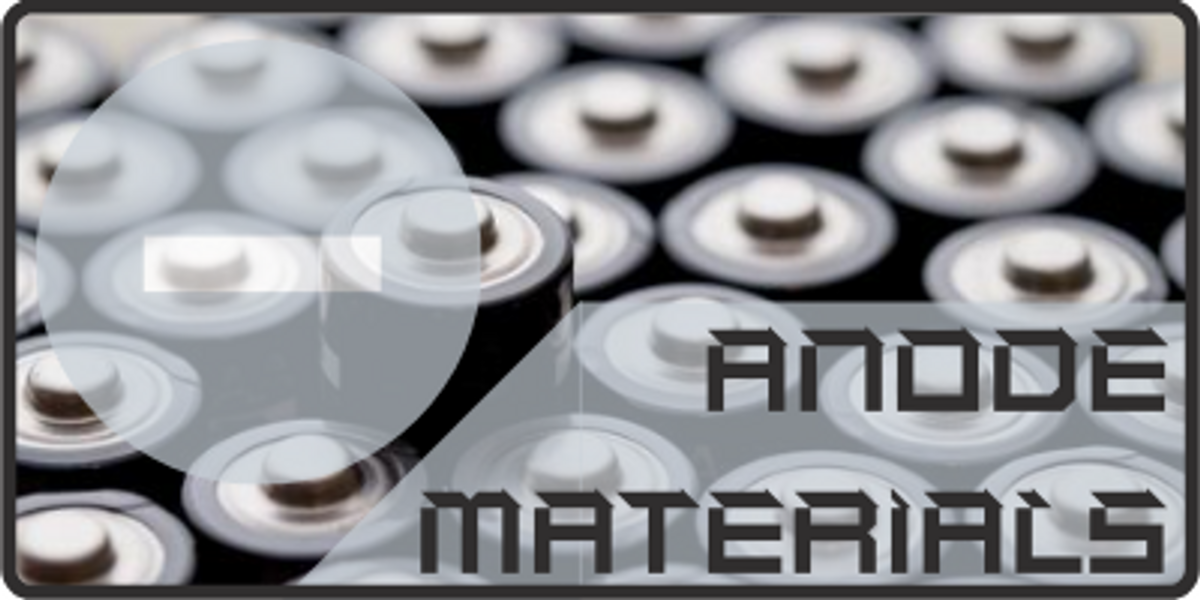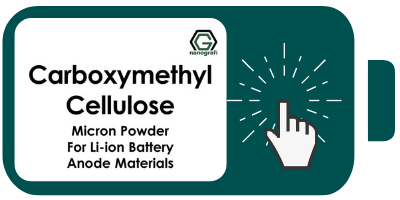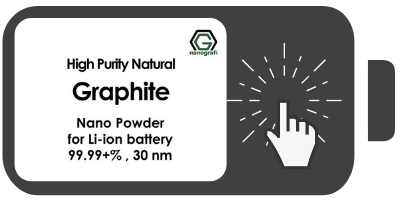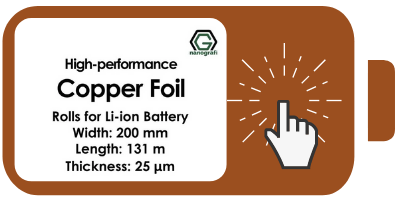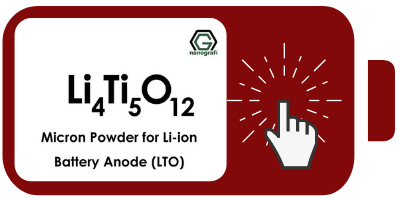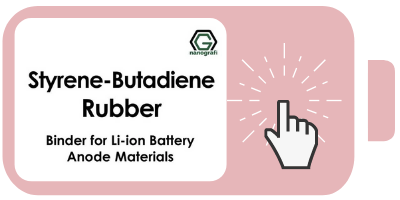Battery Anode Materials
We are all aware of the importance of batteries these days. These are one of the most vital elements in different gadgets and electronic devices available in the market and industry right now, especially the lithium-ion battery. The Li-ion battery is compact, high performing, durable and efficient. The batteries in general consist of two electrodes, positive and negative known as cathode and anode respectively, some electrolyte and a suitable container to contain them in one place.
In this article, we are specifically going to focus on the materials used in the manufacturing of the anode or the negative electrode of the battery. The electrode must be conductive and durable enough to withstand the expectation from it.
Battery cathode materials are explained in detail in another article, which you can access here.
Batteries are the sole components for different project electronic gadgets, devices and other loads of things. No one denies the importance of the battery. A battery is a DC voltage source, usually made up of multiple cells, interconnected in different combinations for customized power. Standard voltages available for battery are 3V, 6V, and 12V. Others are made connecting these values of voltages in series or parallel according to the requirements.
The batteries have two terminals, known as Anode and Cathode. The positive one is called cathode and the negative one is called anode. The reason for the polarity is deficiency and enrichment of electron on respective of the electrodes. There are a lot of options when it comes to the materials used for the construction of the electrodes, either of it, the electrolyte or the general material for the container. In this article, we will discuss the materials, widely used for the construction of the anode, the negative electrode of the battery.
Desired characteristics of the material for Anode
To be appropriate for the choice of producing anode, the following are the desired characteristics for the perfect material:
Exceptional Porosity
Porosity is the measure of empty or void space in the material. It is represented in fraction in 0 or 1 and in percentage from 0 to 100. This property explains that the material that has exceptionally void spaces in the material is more suitable for the anode electrode.
Excellent conductivity
Conductivity is a property of a material that measures quantitively how much amount of current can be pass from this material. And according to this property the material that can be used for anode must be an excellent conductor. We know that between the electrodes of the battery the charges move from anode to cathode. So that why anode material must be an excellent conductor.
Voltage match with the coupled cathode material
This property explains that the voltage of anode and cathode material must be matched. It means their conductivity is almost the same or the amount of voltage that they can pass from them must be matched.
High durability
The durability of the material means the probability and assurance of a material that it is worked fine or correctly without any maintenance in different environments or situation. According to another definition durability is the ability of the material that how long it can exist without permanent deformation by resisting different environments changes like wetting, freezing, drying, heating corrosion, thawing, volatilization or oxidization. So, this property state that the material that has high durability is more suitable for the anode of a battery.
Clean from impurities
Impurity means chemical substances in small amounts in any form gas, liquid or solid which are different from the main composition of the material. In simple words, that extra material in any form solid, liquid or gas that is not used in the composition of the material can be found in impurities. For example, lump of gold can be contained 99.9999% gold but 0.00001% trace material like led, silver, etc. but many people say it pure gold. Another definition says that if a material contains only one type of atoms then it is a pure material and if have more than one type of atoms then it is impure material. So, the property said that the material which is clean from impurities means purer is suitable for anode of the batteries.
Current density < 0.5 Adm-2
Current density is the amount of current that passes from a material’s per unit cross-sectional area. It is expressed in Ampere per square meter. The more the current can pass from a conductor higher is that current density. Current density is a vector quantity that has both a scalar value and a direction. It’s all about the amount of current passing through a region. The formula for calculating current density is:
J=I/A
where I is the amount of current passing through the region in ampere and A is
the cross-section area in m2. So, this property said that those
materials that have current density less than 0.5 Am2 are more
suitable for anode.
Light in weight
This property is simply saying that the materials that have low weights can be used in making anode of the batteries.
Preferably cheaper and readily available
According to this property, the material that is cheaper and can easily available is most preferable to use to make anode.
Materials used for the manufacturing of Anode
Let get into details and discuss the materials used these days for the manufacturing and production of the anode at large scale. The details are as:
Carboxymethyl Cellulose for Battery Anode
One of the most used Anode binder material is Carboxymethyl Cellulose abbreviated as CMC. CMC is a water-based binder, derived from cellulose which is also used in food, pharmaceutical, cosmetic products, detergents, and textile industry. They are used as stabilizers, binders, suspension, emulsion, and thickeners. They are readily available because they are derived from cellulose. It is an exceptional conductor and gets things done very well.
Graphite for Battery Anode
Graphite is one of the most used materials for the manufacturing of electronics useable for their low electrical resistivity, low thermal expansion coefficient, greater crystallinity, and thermal conductivity and resistant to thermal shock. Graphite is not a single material, but it is used in the wide form of family including in powder form of micron and nano level. They undergo a lot of processes before getting shaped into a final product, which includes pyrolysis, graphitization, etc.
Copper foil for Battery Anode
Copper foils are also one of the materials used widely for manufacturing anodes for the batteries. There are foils available of different thicknesses. Using different thickness alter the properties of the anode including the strength, conductivity, durability, etc. They are used mainly in commercial-scale production. It sometimes uses alloys for copper for manufacturing at commercial scale.
Lithium Titanium Oxide (LTO) for Battery Anode
These materials are used as one of the anode production materials. they are used to improve the safety and performance of the battery enhancing the stability as well at very low cost. These materials prevent the battery from overcharging, improves reliability and safety, enhance energy and cell voltages. Except for the batteries, they find their applications in electric and hybrid cars, mobile electronics, medical, space, defense-related and aeronautical devices.
Read More: Lithium Titanate Oxide Micron Powder (LTO) for Li-ion Battery Anode
Nickel tabs for Battery Anode
Different varieties and alloys of nickel and other materials are molded, and tabs are formed from them. These tabs play an important part in the manufacturing of the Lithium cell, which has undoubtful importance these days. Stripes of different materials can be paired and connected as electrode to the cell which can be utilized in many forms. They may be available with or without polypropylene film and yellow or black DNP. The standard specifications of the tabs are given as:
Material options: Many sorts of nickel and its alloy-based tabs
Thickness: 0.010 – 0.150 mm
Tolerance: +/- 10% on thickness
Width: 1.0 – 10 mm
Read More: Use of Nickel Materials in Battery Applications
Polytetrafluoroethylene (PTFE) for Battery Anode
This material is used in Li-ion batteries as a separator. There are other separators also e.g. Inorganic separator, Polymer Nano-Fiber separator and so on but that are not used widely in the industry due to strong hygroscopicity with greater risk of short-circuit in cells. PTFT suspension is used as a common binder in Li-ion batteries due to its good chemical stability and adhesiveness. In suspension PTFE is in the form nanoparticles which play as an adhesive and hold the active material. PTFE binder is different from other binders such as polyvinylidene fluoride and polyvinyl alcohol. And due to its chemical inertness, thermal stability and biological compatibility it is widely used in electronics, medical and chemical industries. According a recent research a composite separator was prepared by PTFE and microporous PE separator. In this separator the PTFE particles are coated by microporous PE separator on both sides without any binder then separator was treated with H2O2/H2SO4 solution to enhance the electrolyte affinity. The properties of separator were evolved in terms of microstructure, thermal shrinkage, morphology, electrolyte wettability, and ionic conductivity.
Read More: PTFE Nanopowder
Styrene-Butadiene Rubber (SBR) for Battery Anode
This material is used in Lithium-ion batteries to prepare for anode as a water-based binder. These batteries are used in laptops and smartphones. One main issue in these batteries is to work at low temperatures so that it can be more useful in different environments and situations like electrical vehicle, aerospace, and military. The SBR is used to solve this problem to improve durability at low temperatures and cycle stability also. SBR binder is more useful because in SBR/CMC anode, form a chemical network on the upper layer of silicon by interacting between carboxylic acid and the hydroxyl groups in Si-C. SBR Specification is given below:
|
|
|
|
|
|
|
|
There are many options to choose from for the production of anodes. All of the materials possess their own characteristics and offer their own properties. Changing the material changes the properties like durability, mechanical strength, thermal expansion, conductivity, resistivity, etc. The lithium-ion battery is the most trending of the batteries these days. They are usually constructed by wrapping the electrodes in a material that can assemble and keep them in one place. Some conducting materials are connected to the electrodes and expanded to get them out of the wrapping to be connected to the gadgets and devices. There are a lot of options to choose from as the material for manufacturing the anode of the battery. Each of the materials possesses its own properties either physical or chemical like thermal expansion coefficient, electrical and thermal conductivity, strength, resistivity, etc. Depending on the required properties and characteristics of the electrodes, battery, and load, a suitable material is chosen for the construction.
Recent Posts
-
Reducing the Carbon Footprint of Nanomaterials
The production of nanomaterials is vital for numerous advanced applications, from healthcare to elec …26th Apr 2024 -
Nanocomposites in Food Packaging
The utilization of nanocomposites in food packaging represents a significant advancement in the fiel …19th Apr 2024 -
What is the Difference Between 7075 and 6061 Aluminum Alloy?
When comparing 7075 aluminum alloy to 6061 aluminum alloy, it's essential to understand their disti …5th Apr 2024

